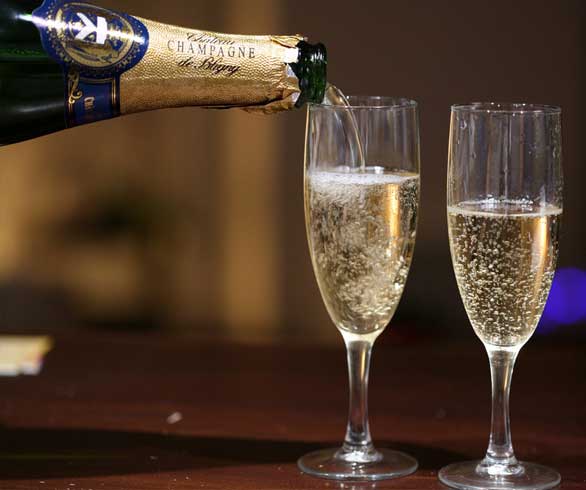
champagne
Thirteen centuries ago, a monk, Dom Perignon, in charge of the wine cellars of the monastery in a place called Champagne was frustrated. The wine was not ‘red’ enough and because of the cooler climate, the fermentation process was disrupted. The chilly winters would halt the fermentation of the grape juice, until the warm springtime would rekindle the process. This disruption caused bubbles to form in the wine, then considered a severe defect. He experimented with various grape varieties and processing methods. But the bubbles persisted. Then one day, his frustration turned to surprise when he tasted the beverage… ‘I am drinking the stars!’ he exclaimed! And thus champagne, the bubbly ‘Rolls Royce of wines’ came into being.
Strictly speaking, Champagne is sparkling wine produced from grapes grown in the ancient French province of Champagne as defined by French law. Furthermore, it must be fermented twice, once in the barrel and then in the bottle. Champagne produced anywhere else is officially labelled “methode champenoise”. Called the ‘barometer of happiness’ by the French, the ultimate drink of success and celebration, Champagne truly has class of its own.
To truly savour good champagne, you should sip it, allowing the bubbles to dissipate in your mouth before you swallow. If you drink it too fast, swallowing all the bubbles, the alcohol will get into your bloodstream too quickly – which usually results in a hangover. Fluted glasses (preferably crystal since the surface texture of crystal is rougher than ordinary glass, more bubbles form) are best for Champagne and sparkling wines as they encourage the bubbles to collect and rise to the top allowing the full aroma to concentrate near the surface. But first the bottle should be opened right, after all the pressure in the bottle and a ballistic cork can seriously injure a bystander. There is a great deal of pressure behind the cork, so carefully remove the foil covering and wire hood. Next ease the cork out, by securing the cork and turning the bottle (held at a 45 degree angle). The bottle will give a classy POP and you won’t lose a single drop of the precious beverage. Go slow when pouring the bubbly to avoid frothing, and allow glasses to settle a moment before topping them off. Never chill or ice the glass as it would take away from the enjoyment of the wine. Champagne is to be served cold at about 43 to 48°F (7°C). This temperature can be achieved by placing the unopened bottle in an ice bucket — one-half ice and one-half water — for 20 to 30 minutes. Or, you may refrigerate it for 3 to 4 hours. It should never be placed in the freezer. Champagne is made to be enjoyed with pleasant company, be it a party, or a romantic dinner for two. Savour the ultimate in wine seduction with your loved one this Valentine’s Day.
Accompanied by Sri Bharat, the son-in-law and TDP-BJP-JSP combine candidate for the Visakhapatnam Lok Sabha…
The mercury levels are reaching new heights every day, and needless to say, it is…
On Thursday, 2 May 2024, the Madhuravada Police, in Vizag, arrested a gang involved in…
On Thursday, 2 May 2024, the Special Enforcement Bureau (SEB) apprehended a couple involved in…
The Jana Sena party chief addressed a public meeting at Poorna Market junction in Visakhapatnam…
Tobacco farmers in Andhra Pradesh are poised to benefit from a significant decrease in crop…
Leave a Comment